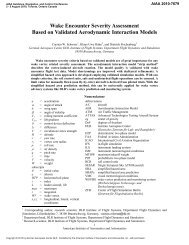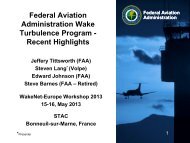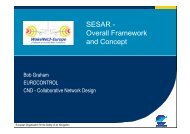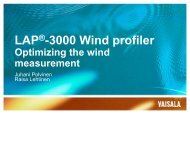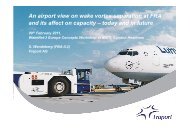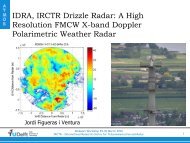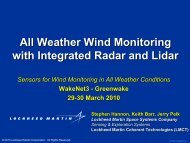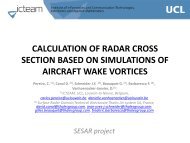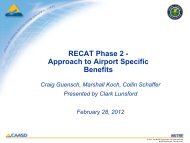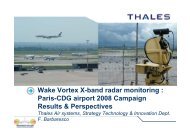SC 186 wake proposal - WakeNet
SC 186 wake proposal - WakeNet
SC 186 wake proposal - WakeNet
- No tags were found...
Create successful ePaper yourself
Turn your PDF publications into a flip-book with our unique Google optimized e-Paper software.
Executive Summary There are many capacity-increasing concepts inthe U.S. in different stages of development‣ Some increase IFR capacity, others increase VMCcapacity There are multiple methods of approving achange to existing separation standards‣ This presentation shows the benefits work being done fortwo different changes Safety, cost / benefit analysis, requiredautomation, and stakeholder acceptance are allconcerns that must be satisfactorily addressed2Federal AviationAdministration
Agenda Overview of US Concepts RECAT Analysis WTMD Analysis Difficult-to-model Benefits3Federal AviationAdministration
Overview of active U.S. concepts Most U.S. <strong>wake</strong>-related concepts are focused onclosely spaced parallel runways, which are prevalentin the U.S.‣ All U.S. airports run visual operations when able, significantlyincrease airport capacity Same-runway concepts are being developedMethods for Avoiding a Wake Vortex4Federal AviationAdministration
Capacity Analysis Research Needs 7110.308‣ Airport/Facility/User requests for assessment‣ Clear indication when procedure is in useWake Turbulence Mitigation for Departures (WTMD) – TrialImplementation Begins 04/2011‣ Airport winds (crosswind availability and stability)‣ ATC and User ParticipationRecategorization of Wake Turbulence Categories (RECAT) – PendingICAO Approval‣ User support‣ ANSP participation Wake Turbulence Mitigation for Arrivals – Procedure (WTMA-P) –Concept Development‣ Wake turbulence data for Heavy and B757 Aircraft as function of winds‣ Airport local winds and geometry‣ National level ATC and user supportWake Turbulence Mitigation for Arrivals – System (WTMA-S) – SystemDevelopment‣ Combined requirements of WTMA-P and WTMD5Federal AviationAdministration
Research Needs Grow with theMaturity of the ConceptWTMD in initial concept stage, initial airport downselect‣ % time surface winds were above a threshold‣ % fleet mixWTMD acquisition phases‣ Added winds aloft‣ Added seasonal and time of day variations‣ Added working version of wind forecast algorithm‣ ASDE-X data‣ Correlated departure demand and procedure availabilityWTMD operational demonstration phase‣ Visual Observation for a few weeks‣ Post-hoc benefits analysis at demo sites‣ Availability vs. Use‣ Verify procedure operates as designed6Federal AviationAdministration
Agenda Overview of US Concepts RECAT Analysis WTMD Analysis Difficult-to-model Benefits7Federal AviationAdministration
Levels of Analysis FidelityAverage Required Minimum Separation Distance (AvgMinSep)x = 2.6245 nmEasy to apply tomany airportsFast turnaroundVery high levelBackground FilesGenerate EquipmentBackgroundFilesAirspaceAirportsFixesARTCCsOperatorsSectorsSector ScheduleTRACONsFleet MixSeparationsQuery FlightsETMS Itinerary File Add VFR andAdjust TaxiTimesAdd ScheduledDepartureASQP TimesScenario GenerationAirport Capacity Simulation with runwaySimulator (rS)Demand GenerationConvertAirframesETMSFileAirframesFile (revised)Airport LayoutItinerary File(adjusted)Link FlightsItinerary File(revised)systemwideModelerResourcesGADSGRASPItinerary FileTransits FileAdaptationCRCT TMTrajectoriesFile4-D TrajectoryModelingTSSIM Airport MAS Fleet ManagerRules1.Heavy aircraft shall…2.Departing Small aircraftshall…3.Converging aircraft…4.Runway 27 shall not beused for…Delivery UncertaintyxxAverage ofHundreds ofHours=35.78 Arrivalsper HourNAS-wide Delay Analysis with systemwideModeler (sM)= 20,253,982Minutes of DelayMany additionalfactors consideredEasy to understandmetricMore realisticbenefits estimatesComprehensivenetwork delay metricSignificant setup andanalysis requiredMonetization ofbenefits possible8Federal AviationAdministration
Worldwide RECAT Analysis MapKSFOKORDKATLMMMXCYYZSKBOCYULKEWRKJFKEGLLLFPGEHAMEDDFUUDDUUEEHECAOERKOMDBVIDPZBAAVTBSZGGGRKSIVHHHRJAARJTTDNMMSBGRWSSSSAEZFAJSYMMLYSSY Airports selected for detailed analysis (Green) Additional airports analyzed to confirm benefits (Blue)9Federal AviationAdministrationSource: http://commons.wikimedia.org/wiki/File:BlankMap-World-v2.png
Worldwide RECAT Benefits (AvgMinSep)20%15%ReductioninAvgMinSep10%5%0%‐5%2.5 nm Sep3.0 nm SepRJAARJTTVHHHRKSIOMDBVTBSSAEZWSSSOERKYMMLUUEEHECAZBAAYSSYSKBOSBGRZGGGVIDPDNMMMMMXCYULUUDDCYYZFAJSAirport (ICAO Code)• Neutral to CYYZ• FAJS not capacityconstrained• No ANSP is required totransition to RECAT Phase I• Unique needs of individualairports provided for inRECAT Phase II This analysis was conducted using OAG data from Fiscal Year 2010.‣ OAG data is only scheduled flights, and doesn’t include cargo, military, or GA flights10Federal AviationAdministration
U.S. Airport RECAT Benefits (rS)14%12%10%MIAIncrease inMaximumCapacity(rS)8%6%4%IAHATLORDEWRONTSFOMIAJFKONTORDSFOEWRIAHDCAATL2%JFK0%DCA0% 10% 20% 30% 40% 50% 60%Percentage of Wake‐Restricted Pairs IAH’s independent runways lead to a steeperrelationship than other airports with arrivaldeparturerunway dependencies11Federal AviationAdministration
U.S. Airport RECAT Benefits (sM)A network delay analysis is currently underwayusing systemwideModeler‣ This analysis requires rS simualtions of 58 airports under3 weather conditions for baseline and treatment cases‣ Uses traffic schedules, fleet mixes and actual weatherdata‣ Detailed - can swap airframes, issue GDPs, etc.The network-wide delay will allow the trickledowneffect of delay and delay mitigation to beevaluatedThe monetization of the reduction in delaybetween the baseline and the treatment case isan estimate for benefits for the treatment12Federal AviationAdministration
Agenda Overview of US Concepts RECAT Analysis WTMD Analysis Difficult-to-model Benefits13Federal AviationAdministration
WTMD Capacity Analysis The FAA Acquisition Management System(AMS) requires an incremental benefitanalysis‣ Shortfall Analysis – Estimate of how large theproblem is and how much of it WTMD will address‣ Investment Analysis (Initial and Final) – Is the benefitof WTMD worth the cost of implementing andoperating it‣ Methods: Analysis, simulation, operationaldemonstration14Federal AviationAdministration
Benefits Estimation MethodsOutput GoalMethodologyTraffic DemandLevelAirport Simulation-BasedCapacity Simulationwith runwaySimulatorEstimationRunway CapacityEnhancement Independentof Current ScheduledDemandDetailed Simulated AirportOperations Combined withAnnual Wind ForecastingAlgorithm OutputsConstant, highCurrent Demand Levelsdemand. Current daytraffic mixDay-in-the-LifeLifeEstimation AnalysisWTMD Estimate Improvement Additional ofCurrent Departures Day Enabled Operations byWTMDHistoricalEstimatedLookCountat theofNumber of Heavy andPossible Additional DailyB757 DeparturesOperationsDuring WTMD PeriodsCurrent Demand LevelsThe two methods providedcomplementaryperspectives on WTMDcapacity:‣ Day in the Life provides abenchmark of capacityincrease with current daydemand‣ Capacity Simulationestimates future capacitywhen demand increasesAnalysis TimeRangeOne YearOne Year DayAdditionalAnalysis OutputAirport OperationsVisualization (FinalApproach, Initial Departure,Arrival/Departure Queues)Correlation Minute-by-Minute of WTMDOperations Periods with Count Heavy Can Beand Compared B757 Departures to DailySchedule15Federal AviationAdministration
Three Airport Sample - Summary ofDelay Savings with WTMDWith Operational Day, Heavy/B757Wind ForecastHeavy/B757 Ceiling/Visibility,DeparturesWith Randomnolonger creatingAlgorithm Heavy/B757 Departures Compatible Runway <strong>wake</strong> Runway delayAirport Green Minutes Departures During Green Direction(random Assignment runway)DTW 92575 25433 4860 3967 1984EWR 110579 48429 10914 10008 5000 5004PHL 78925 28126 4440 4289 2145WTMDAirportHeaviesafter allimpactsAvgQueueperrunwayAvgQueueUntilEmptyperrunwayAircraftImpactedAnnualHours ofdelaysavings2007AnnualBenefit$M (BY2008)Lifecycle(2011-2030)Benefits$M (BY2008)Lifecycle(2011-2030)Benefits$M (PV)DTW 1984 3.37 6.74 13372 432 $1.36 $35.97 $15.94EWR 5000 4.65 9.29 46450 1502 $4.84 $133.51 $58.69PHL 2145 3.81 7.62 16345 528 $1.57 $45.03 $19.64Total $214.51 $94.2716Federal AviationAdministration
WTMD Candidate Airports – Estimated Departures perDay No Longer Incurring Wake Delay(3)(19)(29)(2)(37)(127)(45)(16)(7)(14)WTMD Candidate Airports Shown in WHITE17Federal AviationAdministration
Agenda Overview of US Concepts RECAT Analysis WTMD Analysis Difficult-to-model Benefits18Federal AviationAdministration
Some benefits are hard to modelThe detail of a model is proportional to theeffort required to model it‣ E.g., very detailed models are required for taxiwaycrossingsA procedure might enable flexibility inairport operations not allowed by currentproceduresReduced separations mean fewer controllerwork-arounds are needed to optimize thesystem19Federal AviationAdministration
Conclusions Many concepts show benefits in the U.S.‣ WTMD and RECAT benefits have been shown usingdifferent methodologies Benefits must be accurate and easy toexplain‣ Without stakeholder acceptance, new procedures willnot be used, and benefits will be left unclaimed Increased capacity is not the only benefit‣ Other benefits (increased flexibility, reduced controllerworkload, increased procedure acceptance) are moredifficult to model, but no less important20Federal AviationAdministration
Backup21Federal AviationAdministration
Many airports were examined for internationalbenefitsList of Airports AnalyzedICAO Code IATA Code Airport Name Location Arrivals in DataZBAA PEK Beijing/Captial International Beijing, China 256,879CYYZ YYZ Lester B Pearson International Toronto, Canada 189,840RJTT HND Tokyo Haneda International Tokyo, Japan 181,448ZGGG CAN Guangzhou Baiyun International Guangzhou, China 163,331MMMX MEX Benito Juarez International Mexico City, Mexico 163,036YSSY SYD Kingsford Smith Sydney, Australia 153,442VHHH HKG Hong Kong International Hong Kong, China 139,466OMDB DXB Dubai International Dubai, United Arab Emirates 130,417VTBS BKK Suvarnabhumi International Bangkok, Thailand 128,763WSSS SIN Singapore Changi International Singapore, Singapore 125,232VIDP DEL Indira Gandhi International New Delhi, India 122,893SKBO BOG El Dorado International Bogota, Columbia 108,559YMML MEL Melbourne Airport Melbourne, Australia 103,353SBGR GRU Guarulhos International Sao Paulo, Brazil 100,692RKSI ICN Incheon International Seoul, South Korea 99,521FAJS JNB OR Tambo International Johannesburg, South Africa 97,572RJAA NRT Narita International Tokyo, Japan 92,988UUDD DME Domodedovo International Moscow, Russia 90,901UUEE SVO Sheremetyevo International Moscow, Russia 84,761CYUL YUL Montreal-Pierre Elliot Trudeau International Montreal, Canada 83,961HECA CAI Cairo International Cairo, Egypt 61,196OERK RUH King Khalid International Riyadh, Saudi Arabia 49,652DNMM LOS Murtala Muhammed International Lagos, Nigeria 37,847SAEZ EZE Ministro Pistarini International Buenos Aires, Argentina 27,28422Federal AviationAdministration



